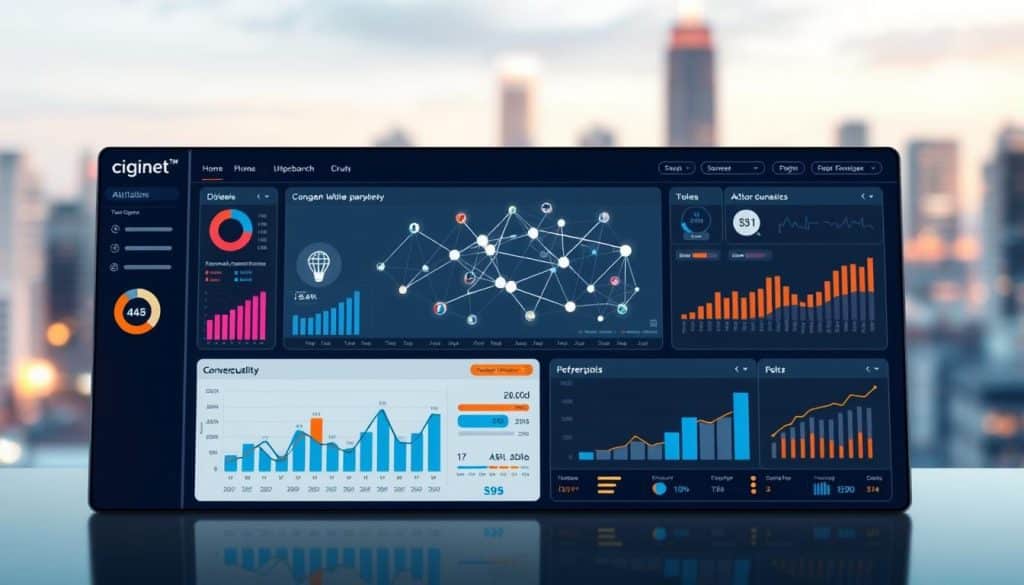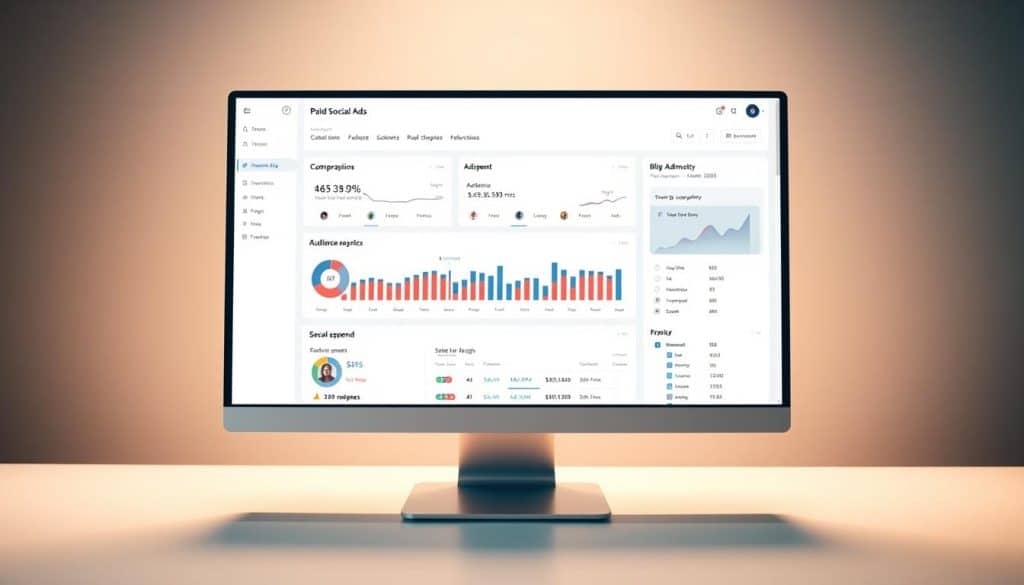Did you know personalized emails get opened 26% more often than generic ones? This shows how powerful personalization is in email marketing. With over half the world’s population checking email every day, it’s key to stand out. We’ve seen firsthand how targeted email campaigns can dramatically improve engagement and conversions.
Personalization in email marketing is more than just using someone’s name. It’s about making emails that really speak to each person. By using what users like and need, businesses can make emails that hit the mark.
Personalized emails really make a difference. They have 29% higher open rates and 41% higher click rates than generic ones. These numbers show how targeted emails grab attention and get people involved.

Even though personalization works well, only 5% of companies really use it in their email marketing. This means there’s a big chance for businesses to stand out. By using personalization, companies can make lasting connections with their audience and see real results.
Email Marketing (Powered by AI Arkitechs)
Smarter Emails, Better Results!
Automate, personalize, and scale your email campaigns with AI-driven marketing. Start optimizing today!
Key Takeaways
- Personalized emails have significantly higher open and click rates
- Most companies underutilize email personalization strategies
- Dynamic content enhances user engagement
- Personalization drives higher conversion rates
- User preferences are crucial for effective email marketing
- Tailored experiences lead to improved customer relationships
Understanding Email Marketing Personalization Fundamentals
Email marketing personalization is more than just adding a name to the subject line. It’s about making messages that speak to each reader. Let’s explore the key elements that make personalization in emails effective.
What Makes an Email Personalized
A personalized email addresses the recipient’s interests, actions, and needs. It uses data to customize content, product suggestions, and timing. Marketers who personalize see a 27% jump in unique clicks and an 11% increase in opens compared to generic emails.
The Psychology Behind Personalized Communication
Personalization connects with our basic human nature. When content feels made for us, we’re more likely to engage. In fact, 80% of consumers are more likely to buy when they get a personalized experience. This is because we feel seen and valued.
Key Components of Email Personalization Strategy
An effective personalization strategy includes several key parts:
- Data collection and analysis
- Customer segmentation
- Email automation
- Predictive analytics
- Omnichannel personalization
Despite its value, only 3% of marketers use live or real-time dynamic content in their personalization. This shows a big chance for brands to shine in a crowded inbox.
| Personalization Tactic | Effectiveness |
|---|---|
| Personalized subject lines | 26% higher open rates |
| Smart CTAs | 202% higher conversion rates |
| Email segmentation | Top tactic for 50% of marketers |
By using these strategies, brands can make more engaging emails that get results. Remember, 76% of buyers expect personalized experiences from brands. Meeting this expectation is key to success in today’s digital world.
Impact of Personalization on Email Marketing Metrics
Personalization in email marketing is a game-changer for businesses. It boosts campaign performance by targeting specific customers. Personalized emails see a 29% open rate and a 41% click-through rate, beating generic messages.
Personalized subject lines make a big difference. They can raise open rates by up to 26%. This makes them 50% more likely to be opened. It shows how important it is to tailor content to each recipient.
Improving email engagement requires a strategic approach. Effective email engagement tips include using attention-grabbing subject lines, segmenting your audience for personalized messaging, and optimizing emails for mobile users.
Personalized emails lead to higher customer engagement. A whopping 72% of consumers only interact with personalized messages. Also, 74% of marketers say targeted personalization boosts engagement. This highlights the need to create content that speaks to each person’s interests and actions.
| Metric | Improvement with Personalization |
|---|---|
| Open Rate | Up to 26% increase |
| Click-Through Rate | 41% higher |
| Conversion Rate | Up to 300% increase |
| Revenue | 760% increase |
The financial gains from personalization are huge. Marketers see a 760% jump in email revenue from personalized campaigns. Personalized product suggestions can also increase conversion rates by 300%.
To make the most of these benefits, consider these tips:
- Use dynamic content for tailored product suggestions
- Segment your audience based on behavior and preferences
- Implement A/B testing to improve personalization
- Optimize emails for mobile devices to boost click-through rates
By using these strategies, businesses can greatly improve their email marketing. They can achieve meaningful results through personalization.
Essential Data Points for Email Personalization
In the world of email marketing, data is key. The right info lets marketers make personalized emails that really connect with people. Let’s look at the important data points for customer-focused marketing.
Customer Demographics and Preferences
Knowing your audience is crucial for personalization. Basic data like age, gender, and location is important. But, knowing what people like is even more vital.
For B2B, knowing the company size and industry is essential. B2C marketers focus on personal interests, birthdays, and shopping habits.
Behavioral Data Collection
How people act is more telling than what they say. Tracking email and website interactions gives deep insights. Email opens, clicks, and browsing patterns show what people are interested in.
This data helps create dynamic content. 36% of email marketers use it for personalized product suggestions and offers.
Purchase History Integration
Past purchases predict future behavior. Using purchase history helps tailor product suggestions and campaigns. This personal touch can lead to big results, with personalized brands earning 40% more than non-personalized ones.
Personalization’s impact is clear. 71% of consumers expect personalized experiences, and 76% get frustrated without it. By using these key data points, marketers can meet these expectations and boost engagement.
Dynamic Content Strategies for Email Campaigns
Email marketing has changed a lot, especially with dynamic content for emails. This method makes messages fit each subscriber better. It helps get more people to engage and buy more.
Product Recommendations Engine
A product recommendations engine uses smart tech to suggest items based on how users act. This makes emails 29% more likely to get opened. For companies in Canada, it can boost engagement by 40%.
Location-Based Content Delivery
For email marketing in Canada, sending content based on where people are is key. This way, emails are 14% more likely to lead to a sale. It lets businesses send out special deals and local info.
Time-Sensitive Offers
Offers that are only good for a short time can really push sales up. Countdown timers can make sales jump by 332%. Dynamic content lets you update emails in real-time, like with weather tips or limited-time offers.
| Dynamic Content Type | Impact on Metrics |
|---|---|
| Personalized Subject Lines | 50% higher open rate |
| Tailored Product Recommendations | 6x higher transaction rates |
| Cart Abandonment Emails | 28% conversion rate |
Using these dynamic content strategies can really help email marketing. It makes messages more personal and effective. This way, marketing gets better and easier, making customer experiences better too.
Personalization in Email Marketing: Tools and Technologies
Email marketing has changed a lot with new tools. These tools use automation, predictive analytics, and omnichannel personalization for better campaigns. Mailmodo has 450+ templates, and ActiveCampaign has 900+ automations for emails.
These tools make a big difference. Personalized emails get opened 26% more than non-personalized ones. Emails with personalized subject lines are 50% more likely to be opened.
Predictive analytics are key in email marketing today. They use data like what customers buy and browse to make accurate profiles. This helps deliver content that’s just right for each customer.
Omnichannel personalization tools make sure customers have the same experience everywhere. Klaviyo has 100+ customizable email templates, and Brevo lets you make dynamic lists with customer data. This helps create messages that really speak to your audience.
These tools are highly rated. Mailmodo and Klaviyo get 4.6 out of 5 stars on G2. ActiveCampaign and Brevo get 4.5 out of 5 stars. This shows how valuable these platforms are for personalizing emails.
Using the right tools can really change your email marketing game. With automation, predictive analytics, and omnichannel personalization, you can make emails that engage and convert. This is how you get better results from your email campaigns.
Advanced Segmentation Techniques for Targeted Emails
Email segmentation has changed the game in digital marketing. It brings in a big return on investment, $36 for every dollar spent. This makes it a key strategy for businesses. Let’s dive into some top-notch segmentation methods to boost your email campaigns.
Behavioral Segmentation Methods
Behavioral segmentation sorts customers by their actions with your brand. It can up conversions by 20% with the right content. By looking at what customers like and buy, you can send emails that really speak to them.
Tailored Email Content
Creating tailored email content ensures that your messages feel relevant and personal to each recipient. By leveraging data insights, businesses can customize subject lines, offers, and recommendations based on customer preferences. This level of personalization improves engagement, enhances brand loyalty, and increases conversion rates in email marketing.
Lifecycle-Based Segmentation
It’s key to tailor content for customers at every stage. For example, sending reminders for abandoned carts can really work. This is especially true since about 70% of carts are abandoned. Targeting in Canada might seem as a complex task, but we suggest you, pay attention to trends, social media, news and more relevant aspects that can help you to chosoe the correct demographic group.
Interest-Based Customer Groups
Segmenting by interests lets you target more precisely. This includes grouping by what features customers use and how often. Emails that are personal can get a 29% open rate, showing how important it is to match content to interests.
| Segmentation Type | Benefits | Implementation |
|---|---|---|
| Behavioral | 20% increase in conversions | Analyze user actions and preferences |
| Lifecycle-Based | Tackles 70% cart abandonment rate | Timely reminders and follow-ups |
| Interest-Based | 29% email open rate | Tailor content to specific interests |
Using these advanced techniques, businesses can make emails that really speak to people. This leads to more engagement and sales. Remember, 75% of people are more likely to interact with content that’s made just for them.
AI and Machine Learning in Email Personalization
AI and machine learning are changing email personalization. They offer tools for better predictive analytics and creating dynamic content. These tools help marketers make campaigns that really speak to each subscriber.
Email automation with AI is changing how businesses talk to their audience. AI looks at how customers interact across different places, finding patterns that help personalize messages. This leads to more people opening and clicking on emails.
Predictive analytics are key in guessing what users will do next. AI can guess if someone will buy something or leave, helping marketers adjust their messages. This insight also helps send emails at the best times, which can really boost click-through rates.
Dynamic content, a big part of AI-driven email marketing, changes based on how users act. For example, AI-powered product suggestions can really increase what people spend on average, with 54% of retailers seeing big gains. Amazon’s “Recommended for you” section, which makes 35% of their sales, shows how powerful AI can be in suggesting products.
As email marketing grows, AI will play a bigger role in making campaigns better and cheaper. Soon, marketers who know AI well will lead most email campaigns, from getting leads to writing messages. This change highlights how important AI and machine learning are for the future of email personalization.
Compliance and Privacy Considerations
In the world of customer-centric marketing, respecting user preferences is key. Email marketing in Canada and worldwide is changing fast. Now, Gmail and Yahoo have new rules for bulk senders.
Data Protection Regulations
Data protection rules are changing fast. In 2023, 13 states brought in new privacy laws, up from five before. Laws like GDPR, CCPA, and CASL set rules for handling data and respecting user rights.
Ethical Data Collection Practices
Collecting data ethically is vital for trust. Using opt-in forms and giving detailed consent options lets customers control their data. Following data minimization and regular consent renewal helps too.
Transparency in Personalization
Being open is essential in personalized marketing. Businesses must tell customers how they use their data and make it easy to opt out. The CAN-SPAM Act says businesses must respect opt-out requests within 10 days. Using privacy tech and training employees also helps protect data and build trust.
By focusing on compliance and privacy, companies can make effective, personalized emails. These emails respect user preferences and build strong customer relationships.
Measuring Personalization Success
It’s key to track how personalization works in email marketing. This helps improve strategies and get better results. By looking at important metrics, businesses can learn a lot about their email campaigns.
Key Performance Indicators
First, find the right KPIs to measure success. Only 30% of companies know how to track personalization well. Important KPIs include conversion rate, click-through rate (CTR), average order value (AOV), and customer lifetime value (CLV). These metrics show how personalization changes customer behavior and business results.

ROI Tracking Methods
Tracking return on investment (ROI) is key to proving personalization’s worth. Some companies have seen huge gains. For example, Sportswear brand On got a 390X ROI from personalization. The Warehouse Group got 11% of their revenue from it, and Bear Mattress saw a 16% revenue increase from personalized recommendations.
Performance Analytics Tools
Using the right tools is essential for analyzing personalization. CRM platforms help segment audiences for more targeted emails. A/B testing is also good to see how personalization compares to non-personalized emails.
By focusing on these areas and using the right tools, marketers can make their email campaigns better. This approach ensures ongoing improvement and gets the most out of personalization in email marketing.
Conclusion
Personalization in email marketing has changed the game for businesses. It helps them engage customers better and boost sales. By using customer data and new tech, companies can make emails that really speak to their audience. Personalized subject lines can make people open emails 26% more often. Also, emails that are personalized can make about 5.7 times more money than those that aren’t.
Personalization does more than just increase sales. It builds stronger bonds with customers. In fact, 78% of people are more likely to buy from brands that know them. This approach not only sells more but also makes customers trust and like the brand more. Adding personal touches to emails can keep customers coming back and help plan future marketing.
To get the most out of email personalization, marketers need to focus on a few key things. They should let subscribers pick what they want to see and how often. They should also use AI to understand their audience better. Adding fun stuff to emails can make them stand out.
Looking ahead, personalization in email marketing will keep getting better. New AI and data tools will help marketers even more. By keeping up with these changes and improving their tactics, businesses can make emails that really connect with people. This will help keep customers coming back and build loyalty over time.
FAQ
What is personalization in email marketing?
Personalization in email marketing means making emails fit each person’s needs. It’s not just about using their name. It’s about sending content that matches their interests and what they like to do.
How does personalization impact email marketing metrics?
Personalization really helps email marketing numbers. It can make emails more likely to be opened by 26%. Clicks can go up by 14%, and sales can increase by 10% or more. It also helps keep customers coming back and makes email marketing more profitable.
What data points are essential for effective email personalization?
Important data includes who the customer is, what they like, and what they’ve bought. This info helps send emails that really speak to each person.
How can dynamic content be implemented in email campaigns?
Dynamic content is used in many ways. It can suggest products, show content based on where you are, and offer deals that are only available for a short time. These methods use data and AI to make emails that feel just right for each person.
What tools and technologies enable sophisticated email personalization?
Tools like email automation, predictive analytics, and omnichannel personalization are key. They help marketers send out emails that are just right for each person, at the right time.
How can advanced segmentation techniques improve email targeting?
Advanced techniques like looking at what people do, where they are in their journey with your brand, and what they’re interested in help a lot. They let marketers send emails that really hit the mark for each group, leading to more people engaging and buying.
What role do AI and machine learning play in email personalization?
AI and machine learning are changing email marketing. They help predict what people will do, adjust emails in real-time, and make sure emails are as effective as they can be. These technologies use lots of data to make emails that really speak to each person.
What are the key compliance and privacy considerations in personalized email marketing?
It’s important to follow rules like GDPR and CCPA, collect data in a way that’s fair, and be clear about how data is used. Marketers need to keep user privacy in mind, offer easy ways to opt out, and make sure personalization is legal and ethical.
How can the success of email personalization efforts be measured?
Success can be seen in things like how many people open emails, click on links, and buy things. Tools for tracking ROI and performance analytics give insights into how well personalization is working. This helps marketers see what’s working and make things even better.
What are some best practices for implementing personalization in email marketing?
Start with good data, segment your audience well, and use dynamic content to send messages that really matter. Always test and improve your campaigns, respect privacy, and make sure the experience is consistent across all touchpoints. It’s also important to be real and not too pushy with personalization.





